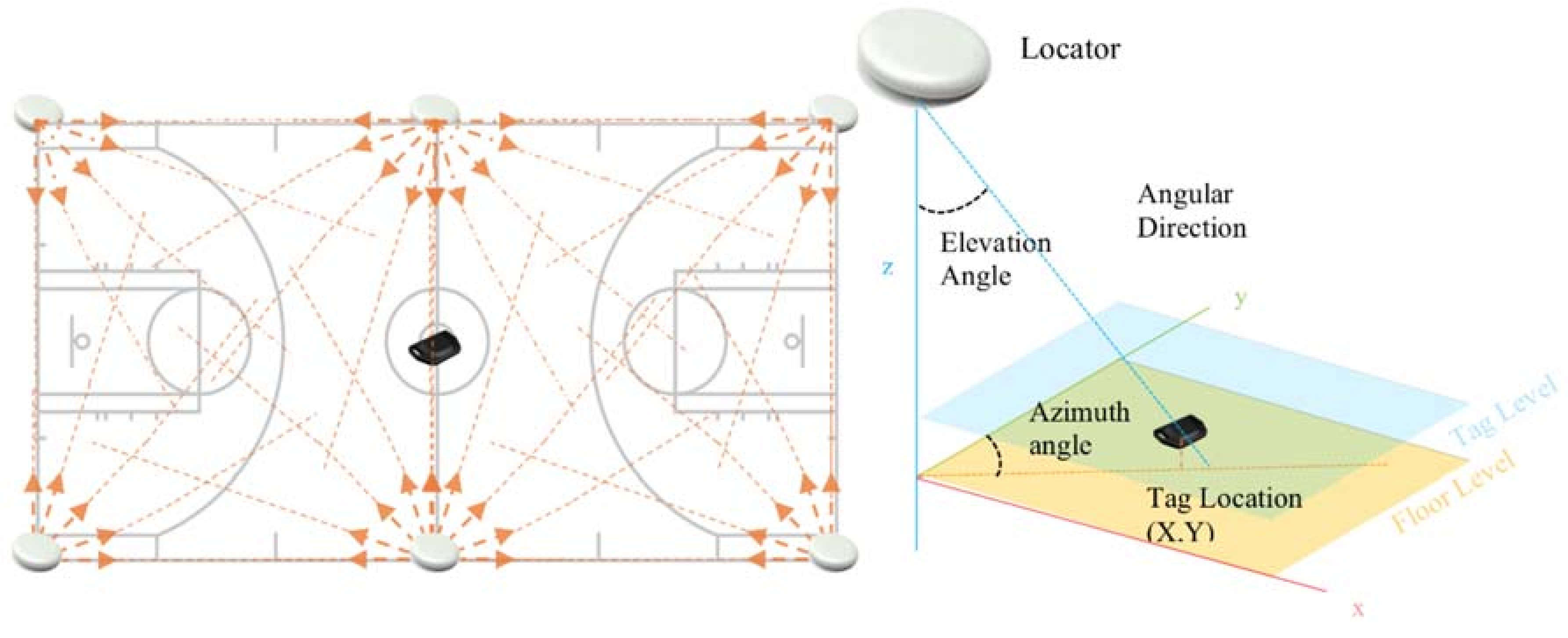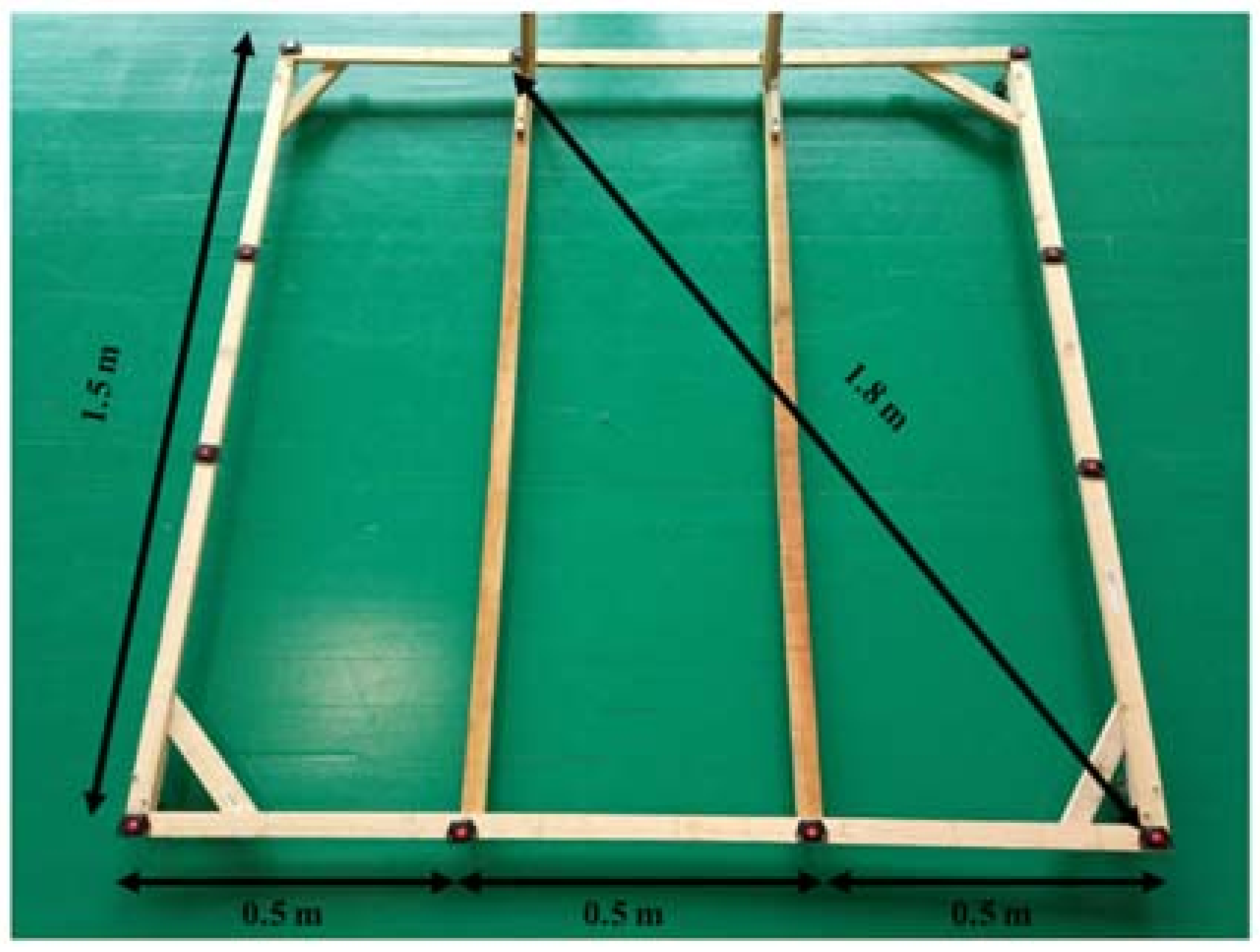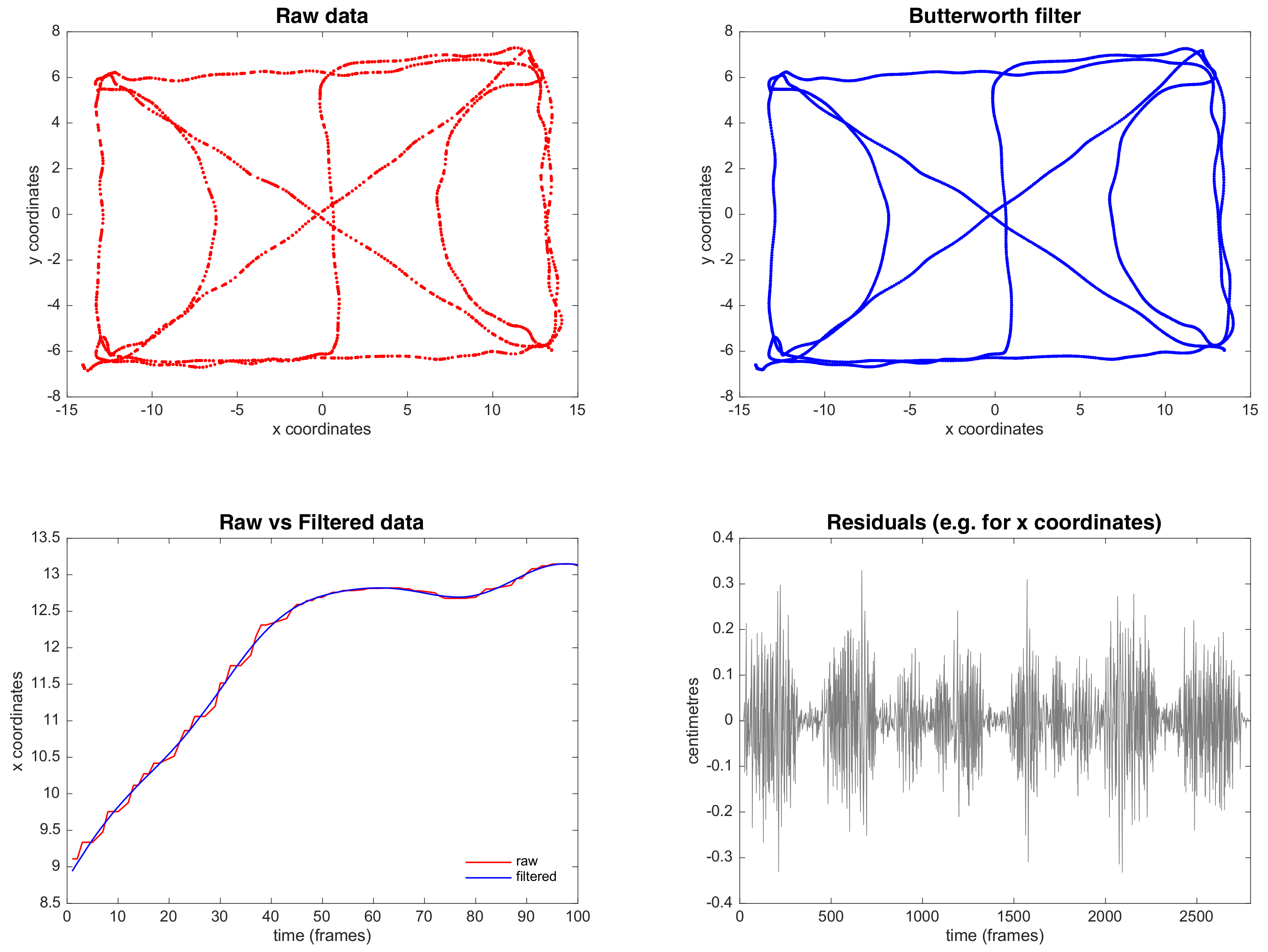Accuracy of a Basketball Indoor Tracking System Based on Standard Bluetooth Low Energy Channels (NBN23®)
Abstract
1. Introduction
2. Material and Methods
3. Equipment
4. Data Collection
5. Data Processing and Analysis
6. Results
7. Discussion
8. Conclusions
Author Contributions
Funding
Conflicts of Interest
References
- Milton, J.; Solodkin, A.; Hlustik, P.; Small, S.L. The mind of expert motor performance is cool and focused. Neuroimage 2007, 35, 804–813. [Google Scholar] [CrossRef] [PubMed]
- Neri, P.; Luu, J.Y.; Levi, D.M. Meaningful interactions can enhance visual discrimination of human agents. Nat. Neurosci. 2006, 9, 1186–1192. [Google Scholar] [CrossRef] [PubMed]
- Di Salvo, V.; Collins, A.; McNeill, B.; Cardinale, M. Validation of Prozone®: A new video-based performance analysis system. Int. J. Perform. Anal. Sport 2006, 6, 108–119. [Google Scholar]
- Redwood-Brown, A.; Cranton, W.; Sunderland, C. Validation of a Real-Time Video Analysis System for Soccer. Int. J. Sports Med. 2012, 33, 635–640. [Google Scholar] [CrossRef] [PubMed]
- Coutinho, D.; Gonçalves, B.; Figueira, B.; Abade, E.; Marcelino, R.; Sampaio, J. Typical weekly workload of under 15, under 17, and under 19 elite Portuguese football players. J. Sports Sci. 2015, 33, 1229–1237. [Google Scholar] [CrossRef] [PubMed]
- Coutts, A.J.; Duffield, R. Validity and reliability of GPS devices for measuring movement demands of team sports. J. Sci. Med. Sport 2010, 13, 133–135. [Google Scholar] [CrossRef] [PubMed]
- Gonçalves, B.; Figueira, B.; Macãs, V.; Sampaio, J. Effect of player position on movement behaviour, physical and physiological performances during an 11-a-side football game. J. Sports Sci. 2014, 32, 191–199. [Google Scholar] [CrossRef] [PubMed]
- Rampinini, E.; Bishop, D.; Marcora, S.M.; Bravo, D.F.; Sassi, R.; Impellizzeri, F.M. Validity of simple field tests as indicators of match-related physical performance in top-level professional soccer players. Int. J. Sports Med. 2007, 28, 228–235. [Google Scholar] [CrossRef] [PubMed]
- Rampinini, E.; Coutts, A.J.; Castagna, C.; Sassi, R.; Impellizzeri, F.M. Variation in top level soccer match performance. Int. J. Sports Med. 2007, 28, 1018–1024. [Google Scholar] [CrossRef] [PubMed]
- Frencken, W.G.P.; Lemmink, K.A.P.M.; Delleman, N.J. Soccer-specific accuracy and validity of the local position measurement (LPM) system. J. Sci. Med. Sport 2010, 13, 641–645. [Google Scholar] [CrossRef] [PubMed]
- Alarifi, A.; Al-Salman, A.; Alsaleh, M.; Alnafessah, A.; Al-Hadhrami, S.; Al-Ammar, M.A.; Al-Khalifa, H.S. Ultra Wideband Indoor Positioning Technologies: Analysis and Recent Advances. Sensors 2016, 16. [Google Scholar] [CrossRef] [PubMed]
- Siwiak, K.; McKeown, D. Ultra-Wideband Radio Technology; John Wiley & Sons: Newark, NJ, USA, 2005. [Google Scholar]
- Porcino, D.; Hirt, W. Ultra-wideband radio technology: Potential and challenges ahead. IEEE Commun. Mag. 2003, 41, 66–74. [Google Scholar] [CrossRef]
- Danis, F.S.; Cemgil, A.T. Model-Based Localization and Tracking Using Bluetooth Low-Energy Beacons. Sensors 2017, 17. [Google Scholar] [CrossRef] [PubMed]
- Rida, M.E.; Liu, F.; Jadi, Y.; Algawhari, A.A.A.; Askourih, A. Indoor location position based on Bluetooth Signal Strength. In Proceedings of the 2nd International Conference of Information Science and Control Engineering, Shanghai, China, 24–26 April 2015; pp. 769–773. [Google Scholar]
- Ogris, G.; Leser, R.; Horsak, B.; Kornfeind, P.; Heller, M.; Baca, A. Accuracy of the LPM tracking system considering dynamic position changes. J. Sports Sci. 2012, 30, 1503–1511. [Google Scholar] [CrossRef] [PubMed]
- Bishop, D.; Spencer, M.; Duffield, R.; Lawrence, S. The validity of a repeated sprint ability test. J. Sci. Med. Sport 2001, 4, 19–29. [Google Scholar] [CrossRef]
- Akenhead, R.; French, D.; Thompson, K.G.; Hayes, P.R. The acceleration dependent validity and reliability of 10 Hz GPS. J. Sci. Med. Sport 2014, 17, 562–566. [Google Scholar] [CrossRef] [PubMed]
- Memmert, D.; Lemmink, K.A.; Sampaio, J. Current Approaches to Tactical Performance Analyses in Soccer Using Position Data. Sports Med. 2016, 47, 1–10. [Google Scholar] [CrossRef] [PubMed]
- Sampaio, J.; McGarry, T.; Calleja-Gonzalez, J.; Saiz, S.J.; del Alcazar, X.S.I.; Balciunas, M. Exploring Game Performance in the National Basketball Association Using Player Tracking Data. PLoS ONE 2015, 10. [Google Scholar] [CrossRef] [PubMed]
- Quuppa. Available online: http://quuppa.com/features/ (accessed on 28 February 2018).
- Winter, D.A. Biomechanics and Motor Control of Human Movement, 4th ed.; John Wiley & Sons: Hoboken, NJ, USA, 2009. [Google Scholar]
- Rawstorn, J.C.; Maddison, R.; Ali, A.; Foskett, A.; Gant, N. Rapid directional change degrades GPS distance measurement validity during intermittent intensity running. PLoS ONE 2014, 9, e93693. [Google Scholar] [CrossRef] [PubMed]
- Dellal, A.; Hill-Haas, S.; Lago-Penas, C.; Chamari, K. Small-sided games in soccer: Amateur vs. professional players’ physiological responses, physical, and technical activities. J. Strength Cond. Res. 2011, 25, 2371–2381. [Google Scholar] [CrossRef] [PubMed]
- Waldron, M.; Worsfold, P.; Twist, C.; Lamb, K. Concurrent validity and test-retest reliability of a global positioning system (GPS) and timing gates to assess sprint performance variables. J. Sports Sci. 2011, 29, 1613–1619. [Google Scholar] [CrossRef] [PubMed]
- Ahrestani, F.S.; Hebblewhite, M.; Post, E. The importance of observation versus process error in analyses of global ungulate populations. Sci. Rep. 2013, 3, 3125. [Google Scholar] [CrossRef] [PubMed]





| Real Distance (meters) | Movement Speed | Root Mean Square Error (meters) | Percentage of Variance Accounted for (%) |
|---|---|---|---|
| 0.5 (n = 8) | Low (<10 km/h) | 0.22 ± 0.04 | 86.16 ± 3.05 |
| Medium (10 to 20 km/h) | 0.28 ± 0.05 | 82.27 ± 3.01 | |
| High (>20 km/h) | 0.37 ± 0.13 | 75.86 ± 10.31 | |
| 1.0 (n = 6) | Low (<10 km/h) | 0.23 ± 0.02 | 94.73 ± 0.73 |
| Medium (10 to 20 km/h) | 0.28 ± 0.03 | 93.22 ± 1.71 | |
| High (>20 km/h) | 0.32 ± 0.07 | 88.82 ± 6.7 | |
| 1.5 (n = 6) | Low (<10 km/h) | 0.26 ± 0.03 | 96.74 ± 0.86 |
| Medium (10 to 20 km/h) | 0.29 ± 0.07 | 95.9 ± 1.92 | |
| High (>20 km/h) | 0.36 ± 0.15 | 94.15 ± 4.34 | |
| 1.8 (n = 6) | Low (<10 km/h) | 0.26 ± 0.04 | 97.67 ± 0.67 |
| Medium (10 to 20 km/h) | 0.30 ± 0.02 | 97.19 ± 0.46 | |
| High (>20 km/h) | 0.40 ± 0.17 | 93.76 ± 6.1 |
© 2018 by the authors. Licensee MDPI, Basel, Switzerland. This article is an open access article distributed under the terms and conditions of the Creative Commons Attribution (CC BY) license (http://creativecommons.org/licenses/by/4.0/).
Share and Cite
Figueira, B.; Gonçalves, B.; Folgado, H.; Masiulis, N.; Calleja-González, J.; Sampaio, J. Accuracy of a Basketball Indoor Tracking System Based on Standard Bluetooth Low Energy Channels (NBN23®). Sensors 2018, 18, 1940. https://doi.org/10.3390/s18061940
Figueira B, Gonçalves B, Folgado H, Masiulis N, Calleja-González J, Sampaio J. Accuracy of a Basketball Indoor Tracking System Based on Standard Bluetooth Low Energy Channels (NBN23®). Sensors. 2018; 18(6):1940. https://doi.org/10.3390/s18061940
Chicago/Turabian StyleFigueira, Bruno, Bruno Gonçalves, Hugo Folgado, Nerijus Masiulis, Julio Calleja-González, and Jaime Sampaio. 2018. "Accuracy of a Basketball Indoor Tracking System Based on Standard Bluetooth Low Energy Channels (NBN23®)" Sensors 18, no. 6: 1940. https://doi.org/10.3390/s18061940
APA StyleFigueira, B., Gonçalves, B., Folgado, H., Masiulis, N., Calleja-González, J., & Sampaio, J. (2018). Accuracy of a Basketball Indoor Tracking System Based on Standard Bluetooth Low Energy Channels (NBN23®). Sensors, 18(6), 1940. https://doi.org/10.3390/s18061940







